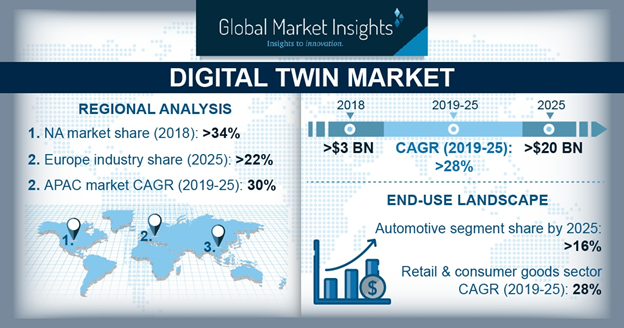Global digital twin market size to exceed $20bn by 2025

Digital Twin Market size is set to exceed US $20 billion (€17 billion) by 2025; according to a new research report by Global Market Insights, Inc.
The digital twin market growth is attributed to the increasing adoption of the IoT and IIoT and the rapidly growing digitalisation in manufacturing, automotive, and healthcare industries. The continuously rising adoption of the IoT that is empowered & backed by 3D simulation, deep learning, Artificial Intelligence (AI), and big data analytics will help in the cost-effective implementation of digital twin in aerospace & defense, healthcare, and retail & consumer goods sectors.
The digital twin enables real-time and predictive analytics, helping in cost & time savings. For instance, in the aviation sector, GE helps its client companies in understanding airline routes, dynamic optimisation of maintenance schedule of jet engines, and maintenance shop availability through digital twin with the help of its Predix platform.
The rising demand for reducing asset downtime, optimising process time, reducing time-to-market, reducing asset downtime, and improving operational efficiency is proliferating the growth of the digital twin market. The supportive government initiatives related to the construction of smart cities and energy-efficient smart buildings are anticipated to drive the market over the forecast timeline. For instance, in January 2018, the Singapore government invested approximately US $73 million (€65 million) in data-rich, live digital twin of the Singapore city. This will help officials make the best urban planning decisions and communicate with citizens by sharing information visually.

The process support & service application are anticipated to exhibit a lucrative growth at a CAGR of over 30% between 2019 and 2025. This application include inventory management services and supply chain management services. The use of digital twin in these application enables effective inventory optimisation by allowing organisations to reduce inventory up to a considerable percentage to free up the working capital from unnecessary inventory buffers. This also facilitates reduced inventory carrying costs and increased customer service performance.
Browse key industry insights spread across 200 pages with 157 market data tables & 36 figures & charts from the report, “Digital Twin Market Size By Application (Product Design & Development, Machine & Equipment Health Monitoring, Process Support & Service), By End Use (Manufacturing, Healthcare, Automotive, Aerospace & Defense, Infrastructure Buildings, Energy & Utility, Retail & Consumer Goods), Industry Analysis Report, Regional Outlook (U.S., Canada, UK, Germany, France, Italy, Spain, Netherlands, China, Japan, India, Australia, South Korea, Brazil, Mexico, South Africa, GCC), Growth Potential, Competitive Market Share & Forecast, 2019 – 2025” in detail along with the table of contents
The healthcare sector is anticipated to hold a significant market share in the digital twin market. The digital twin offers real-time monitoring & analytics with machine learning and helps to streamline operations & processes in hospitals, improving customer experience. For instance, a single MRI scanner produces an average of 800,000 log messages, which reflects how a system works technically. The proactive remote monitoring services with the digital twin of MRI scanner will help to track & analyse these log messages for early warning signs of impending technical issues.
The manufacturing sector is expected to secure a market share of over 25% in digital twin market by 2025. This impressive growth is attributed to the robust growth of the manufacturing sector after Industry 4.0 and the emergence of automation systems in the manufacturing sector to rapidly increase production capacities. According to the World Bank, manufacturing globally contributed to 16% of the total economic value in 2016. This steady growth of the sector is expected to further fuel the demand for digital twin to streamline and optimise the manufacturing process flows.
The Asia Pacific digital twin market is projected to register an excellent growth with a CAGR of around 30% between 2019 and 2025. The growing adoption of the IoT and IIoT due to increasing internet penetration coupled with the proliferation of smartphones is fueling the market. The presence of prominent automotive players in the countries including Japan, South Korea, and India is contributing immensely to the digital twin market growth.
Additionally, this growth can be attributed to the rapidly evolving e-commerce ecosystem along with heavy investments from venture capitalists to leverage the growing demand for the online market. In 2017-2018, the retail shrinkage percentage of sales in the Asia Pacific region was estimated at around 1.75%, amounting to nearly US $24 billion (€21 billion). To tackle the growing concerns related to inventory shrinkage, the uptake of digital twin in the region is expected to grow consistently over the forecast timeline.
The companies operating in the digital twin market are focusing on technological innovations, strategic acquisitions, and mergers to strengthen their market position and acquire new customers. For instance, in May 2019, Bentley Systems acquired Keynetix, a UK-based provider of cloud-based software for capturing, modeling, visualising, and sharing geotechnical data to build subsurface digital twins. These models of underground assets and environments for infrastructure projects will be easily monitored in real-time.
Some of the key players operating in the digital twin market are ABB Group, Ansys Inc., Autodesk Inc., Dassault Systèmes, General Electric, IBM Corporation, Microsoft Corporation, Oracle Corporation, Robert Bosch GmbH, SAP SE, Siemens AG, and Wipro Limited.
Comment on this article below or via Twitter @IoTGN
